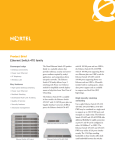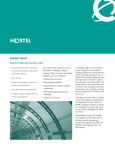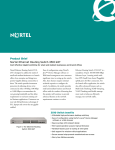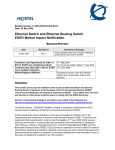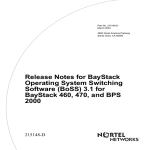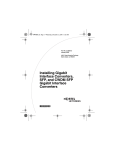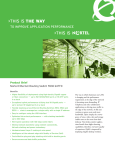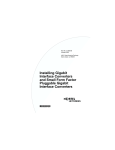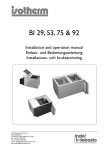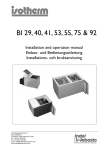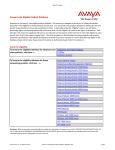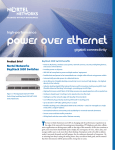Download Nortel Ethernet Switch 425-24T + EU Power Cord
Transcript
Product Brief Nortel Ethernet Switch 425 Highlights > Cost-effective stackable switching for small and medium enterprise customers > Up to 384 10/100 Mbps ports for desktop switching in an 8-rack unit high design > Plug-and-play stacking with builtin stacking ports > Easy to use > Flexible combo uplink ports for wiring closet or backbone connections > Resilient uplink connectivity for minimal network downtime > Easy Web-based management > 1U high compact design with low power consumption > Flexible stacking across Ethernet Switch 425 switches — a stack is managed as a single entity with a single IP address Small and medium enterprises are faced with different challenges than larger enterprises. When it comes to networking equipment, they are looking for: > Minimal time for set-up > Plug-and-play capability > Opportunities to improve employee productivity > Potential for gaining competitive advantage > Ability to save money The Nortel Ethernet Switch 425 (formerly known as BayStack 425 Switch) product family has been designed to address the needs of small to medium customers and larger enterprises. The switches help save money by allowing devices to be connected at either 10 Mbps or 100 Mbps without needing newer switches to accommodate different speeds. In addition, as these are stackable switches, the Ethernet Switch 425 family provides investment protection to the small and medium enterprise as the company grows. Furthermore, easy Web-based management features and plug-and-play stacking ports save customers significant time during the initial set-up as well as throughout the life of the switch, thus significantly minimizing the overall total cost of ownership. Nortel Ethernet Switch 425 switches are stackable 10/100 Mbps Layer 2 Ethernet switches featuring easy configuration and Figure 1. Ethernet Switch 425-24T Figure 2. Ethernet Switch 425-48T stackability, flexible choices for high-speed uplinks, and Web-based management using a Web browser. The Ethernet Switch 425 products have been architected to support DiffServ classification for advanced Quality of Service (QoS). Combining high port density with low per-port pricing for a cost-effective switching solution, the Ethernet Switch 425 family is designed for small to medium-sized enterprises and branch offices that consider price to be a predominant decision factor when acquiring advanced networking functionality such as: > High-density, cost-effective stackable switching > Flexible combo uplink port options 10/100-Mbps ports. Advanced features such as Distributed Multi-Link Trunking, IGMP Snooping, VLAN Trunking and flexible management tools help efficiently manage the network traffic. Nortel Ethernet Switch 425 products are ideal stackable switching solutions for small and medium enterprises needing performance and scalability at cost-effective prices. Features and benefits Wire-speed throughput High-speed switching ASICs support full line-rate forwarding and filtering across all ports. The Ethernet Switch 425-24T leverages a 16-Gbps architecture to deliver a peak forwarding rate of 6.6 million packets per second (Mpps) and up to 52.8 Mpps in a full stack. The Ethernet Switch 425-48T leverages a 32-Gbps switching architecture to deliver a peak forwarding rate of 10.2 Mpps and up to 81.6 Mpps in a full stack. Auto MDI/MDI-X The Ethernet Switch 425 products can be connected to a hub or another switch quickly and cost-effectively. Instead of requiring a crossover cable for this purpose, with the Ethernet Switch 425 you can use either a crossover or straightthrough cable. When a cable is connected to one of the 10/100 ports on the switch, the switch port automatically detects the signal on the cable and configures itself. This feature eliminates the need for an MDI/MDI-X port; any port may be used for connection to another hub or switch. Full autosensing on every port Every UTP port on the Ethernet Switch 425 switches is equipped with autonegotiation technology to automatically detect and support the speed and mode of a connected device. The ports determine whether a connected device is operating at 10 Mbps or 100 Mbps and automatically adjust to the optimal Figure 3. Small/medium enterprise solution 10/100 Mbps connections Floor 3 > Easy set-up The Ethernet Switch 425 switches are available in two models — the Ethernet Switch 425-24T switch and the Ethernet Switch 425-48T switch. The Ethernet Switch 425-24T switch has 24 10BASE-T/100BASE-TX autosensing ports, two flexible combo uplink ports and built-in stacking ports. The switch can be used either as a standalone unit or in a stack of up to eight switches that can be easily managed as a single unit, to provide up to 192 10/100-Mbps ports plus eight flexible combination gigabit ports. The Ethernet Switch 425-48T can also be used as a standalone or in a stack of up to eight switches for up to 384 2 Ethernet Switch 425 Floor 2 Distributed Multi-Link Trunking Ethernet Switch 425 Network Center Ethernet Routing Switch 1612G Servers Multi-Link Trunking speed. Each of the switched ports can also automatically detect and support full-duplex connections to servers, poweruser end stations or other switches, as well as half-duplex connections to legacy devices or hubs. Custom Auto Negotiation Advertisements (CANA) CANA enables the network manager to tune the autonegotiation capabilities of any particular Ethernet port. The capabilities include half-duplex and fullduplex modes with speeds of 10, 100 and 1000 Mbps. This feature enables the network manager to determine which capabilities should be set as the maximum supported on the network and saves the network manager from having to go to each workstation and switch to configure a “fixed” speed. The switch can then negotiate with the connected device for the highest common capabilities according to the parameters defined by CANA for that port. This can be particularly useful where the network manager wished to limit the maximum speed or duplex due to cabling limitations or business requirements. High-density stacking architecture The plug-and-play stacking architecture of the Ethernet Switch 425 permits the inter-connection of up to eight switches with stacking cables into a single manageable entity of up to 384 10/100-Mbps ports. Two built-in Gigabit stacking ports in the rear of the switch provide easy connections to other members of the stack; there is no need to purchase a cascade module or use an uplink port for stacking. This scalable stacking architecture of the Ethernet Switch 425 protects the network investment as business needs change or grow. Enabling users to increase the port density at the wiring closet as the busi- ness expands as well as providing high availability through features such as Nortel’s Distributed Multi-Link Trunking (DMLT) are some of the key advantages of Nortel’s stacking technology. The Ethernet Switch 425-24T and Ethernet Switch 425-48T can be stacked in combination as of version 3.6 software to deliver added flexibility for customer configurations. To further enhance the flexibility of stacking, the Ethernet Switch 425-24T switch can be stacked using version 3.1 or earlier software in any combination up to a maximum of eight units. High-speed uplink ports The Ethernet Switch 425 switches offer two built-in combo uplink ports (ports 25 and 26 on the Ethernet Switch 425-24T and ports 49 and 50 on the Ethernet Switch 425-48T) in the front of the unit that provide high-speed connectivity to backbone switches or servers. Each combo port consists of one SFP GBIC (Small Form Factor Pluggable Gigabit Interface Converter) port and one 10/100/1000BASE-T port. Each combo port autosenses between the SFP GBIC and the 10/100/1000BASE-T port and will enable either the SFP port or the 10/100/1000BASE-T port depending on the presence of a link. In a stack of eight Ethernet Switch 425 products, up to eight uplink ports can be used, delivering up to 16 Gbps of uplink bandwidth. Figure 4. The plug-and-play architecture allows easy expansion and management as a single unit Layer 2 features VLAN support The Ethernet Switch 425 family of products supports up to a maximum of 255 port-based VLANs which can be established for each switch, to extend the broadcast domain and segment network traffic for higher network efficiency. The 255 VLANs can be configured on a standalone switch or across the stack. IEEE 802.1Q VLAN Trunking is supported on every port of the switch, allowing efficient means of transporting broadcast domains across switches. Additionally, the Ethernet Switch 425 provides the ability to have both tagged and untagged frames on the same port for easy traffic segmentation with minimal setup. Figure 5. Each combo port auto-senses between 1 SFP uplink port and 1 10/100/1000BASE-T port Combo Port 26 Combo Port 25 3 Enterprise-sized MAC address table The Ethernet Switch 425 switches support up to 8,000 MAC addresses to support ample scalability for growing networks to accommodate many attached devices and workgroups connected to each switch. IGMP snooping The Ethernet Switch 425 products from Nortel feature IP Multicast support by enabling the examination (‘snooping’) of all Internet Group Multicast Protocol (IGMPv1 and IGMPv2) traffic. This function is performed in hardware and enables the filtering out (dropping) of multicast streams not of interest to particular end stations, thereby enabling peak computer performance. Spanning Tree Protocol Built-in support for Spanning Tree Protocol (IEEE 802.1D) detects and eliminates logical loops in the network. When multiple paths exist, the switch will automatically place some ports on standby to form a network with the most efficient traffic pathways, avoiding the formation of loops within the network. Rapid Spanning Tree Protocol Rapid Spanning Tree Protocol (RSTP or IEEE 802.1w) is a newer version of IEEE 802.1D Spanning Tree that provides a more rapid recovery from network failures. In certain configurations, the recovery time of RSTP can be reduced to one second. RSTP also reduces the amount of flooding in the network by enhancing the way Topology Change Notification (TCN) packet is generated. Multiple Spanning Tree Protocol Multiple Spanning Tree Protocol (MSTP or IEEE 802.1s) allows you to configure multiple instances of RSTP on the same switch or stack. Each RSTP instance can 4 include one or more VLANs, thereby enabling the configuration of multiple spanning tree domains. Link Aggregation Control Protocol Link Aggregation (LA or 802.3ad) allows for the dynamic creation and management of trunk groups. Network administrators can configure a trunk group automatically through the use of the Link Aggregation Control Protocol (LACP). LACP is a dynamic protocol defined by the IEEE 802.3ad standard that allows a switch to learn the presence and capabilities of another switch by exchanging information before a trunk group is formed. Either switch can accept or reject the aggregation request on a per-port basis. A link that cannot join a trunk group can continue to operate as an individual link. 802.3ad provides an industry-standard method for bundling multiple links together to form a single trunk between two networking devices. Trunks that conform to the 802.3ad standard are Link Aggregation Groups (LAGs). The maximum number of LACP-based trunk groups on a switch (in either standalone or stacked configuration) is six with a maximum of four ports active for each trunk group. Multi-Link Trunking Multi-Link Trunking (MLT) enables grouping of links between an Ethernet Switch 425 and another switch or a server to provide greater bandwidth with active redundant links. Nortel’s unique Distributed Multi-Link Trunking (DMLT) feature allows trunked ports to span multiple units of the stack for redundant connectivity to mission-critical servers and the network center. The Ethernet Switch 425 supports up to six MLT groups per switch or stack with up to four ports per MLT. Switch security IEEE 802.1x For added security, Ethernet Switch 425 models support the 802.1x-based security feature. Based on the IEEE 802.1x standard, EAP limits access to the network based on user credentials. A user is required to “login” to the network using a username/password; the user database is maintained as a centralized authentication server, enabling common management of users. EAP prevents connectivity to the network without password authorization for added security and control. It is typically used where access to the network is not 100 percent physically secure or where physical security requires additional enhancement. Some companies will deploy EAP as standard for all network ports to provide an added layer of network defense, requiring that all users are authenticated before access is granted. EAP supports client access to the network and interoperates with Microsoft Windows XP and other compliant 802.1x clients. MAC address-based security BaySecure MAC address-based security allows authentication of all access, not only to the switches for management and configurations, but also access to the infrastructure through these switches. This software feature limits access via proper MAC address identification (up to a maximum of 448). Destination Address filtering Destination Address filtering allows the extension of the MAC address-based security feature (BaySecure) to configure the switch to drop all packets with specified MAC DAs. The Ethernet Switch 425 will support up to 10 specific MAC DAs to be blocked due to security or management requirements. RADIUS authentication HTTP port number change DSCP classification The RADIUS security feature allows the Ethernet Switch 425 to require a username and password to access the switch. This username and password have the advantage of being centrally administered, allowing easy changes and access control to be granted for switch access (including Console, Telnet and Web). In the event that the RADIUS server is unreachable, the network manager can use the local switch password to log into the switch. This feature allows you to specify the UDP/TCP port number to be used for Hypertext Transfer Protocol (HTTP) switch connections. Beginning with software release 3.5, the HTTP port number can be changed to enhanced security and network access. This feature enables the Ethernet Switch 425 models to classify the DiffServ Code Point (DSCP) field within the incoming IP packet. Based on the classification of the DSCP value, the switch can prioritize the packet to any one of eight possible 802.1p priorities within the switch. This can then enable the prioritization of specific traffic types — for example, voice based on the DSCP setting. Secure Shell Access (SSH) Secure Shell (SSHv2) supports strong authentication and encrypted communications to the switch for management. An SSH connection from a client to the switch provides a secure network connection for menu or CLI commands. This feature is ideal for security-conscious customers. SNMPv3 SNMPv3 provides user authentication and data encryption for higher security for switch management via SNMP. It also offers secure configuration and monitoring and can be used in combination with Nortel network management applications. Traffic management and Quality of Service IEEE 802.1p priority queuing 802.1p priority queuing is a standardsbased Quality of Service mechanism that enables the Ethernet Switch 425 to forward packets in priority order on a per-port basis. 802.1p can be utilized if VLAN tagging (802.1Q) is enabled on the port as the priority information is contained in the 802.1Q VLAN tag. The Ethernet Switch 425 supports four queues for the classification and prioritization on network traffic. For example, if messages from a specific segment are crucial to the network, the switch port connected to that segment can be set to a higher priority level to ensure that traffic is queued to the destinations before other traffic. Figure 6. Distributed Multi-Link Trunking (DMLT) across a stack Broadcast and Multicast Rate Limiting Broadcast and Multicast Rate Limiting allow the switch to apply limits to the amount of incoming broadcast and multicast traffic across the switch. The thresholds can be configured according to network requirements, enabling the administrator control over this type of traffic which can cause disruption to other normal data. If the configured threshold is exceeded on a port, the switch will drop extra packets received to protect the network. Switch management Default IP address The Ethernet Switch 425 enables rapid setup through the setup of a Default IP address. This enables an administrator to connect to the switch using a standard network cable and configuration can then quickly occur using any of the following features. Username and password authentication DMLT across the stack with load-balancing and fail-over protection for uninterrupted access to servers or the network center Ethernet Switch 425 switches The Ethernet Switch 425 provides local switch management using username and password authentication. The network manager can assign Read Only or Read/ Write privileges to different users for management access to the switch. Server Ethernet Routing Switch 1612G 5 Web Quick Start The Web Quick Start feature allows the administrator to set up basic configurations on the Ethernet Switch 425 using a single Web page. This significantly reduces complexity and speeds system installations. Web management Web-based network management makes managing the Ethernet Switch 425 easy using a standard Web browser. Summary, configuration, fault, statistics, application, administration and support pages are provided. Real-time sampling provides up-to-date LED and statistical information. The Web interface also allows for configuration of numerous parameters of the switch. software updates. A single image is all that needs to be downloaded from the Nortel Web site for all Ethernet Switch 325/425 models and can also be used with Ethernet Switch 420 switches. When in a stack, the image is loaded only to the base unit of the stack, which automatically loads it to other switches, minimizing the complexity of upgrading software images. SNMPv1 and v2 support Full SNMP manageability is supported across the Ethernet Switch 425 family. Users can configure SNMP communities as well as establish access levels. Traps are also supported with the additional ability to change the UDP port to which traps are sent for security. Nortel Command Line Interface (NNCLI) NNCLI provides a common industry look and feel to the CLI commands, thus helping to reduce training and operational costs. The NNCLI is used through a Telnet session or through the serial port on the console. NNCLI can be used to automate general management and configuration of Ethernet Switch 425 models. ASCII configuration file Java Device Manager Single stack management The process of configuration begins with a single device but finishes across multiple devices. Java Device Manager is the device configuration tool for those functions that require communicating with a single device. It uses a common user interface and workflow that supports many Nortel Ethernet switches. This commonality allows the network manager to become familiar with one tool to configure their network with a simple graphical user interface. Nortel was the pioneer in stacking technology. The Ethernet Switch 425 features some of these unique benefits, enabling single IP address management, configuration and operation of up to eight switches in a stack. Ethernet Switch 425 models can download a user-editable ASCII or binary configuration file from a TFTP server. The ASCII configuration file can be loaded automatically at boot time or on-demand using the management systems (console menus or CLI). Once downloaded, the configuration file automatically configures the switch or stack according to the CLI commands in the file. This feature allows the flexibility of creating command configuration files that can be used on several switches or stacks with minor modifications. Advanced management features ASCII configuration generator The BootP and Trivial File Transfer Protocol (TFTP) protocol support allows for simplified and centralized switch IP address assignment, configuration and software upgrades over the network. This feature provides the ability to view and store the switch configuration in ASCII configuration. The generated file can be stored on an external server and also used to restore the switch configuration. User interface push button Recovery configuration file support Ethernet Switch System Software Ethernet Switch System Software provides a single software image that is used for Ethernet Switch 325-24T, 325-24G, 425-24T and 425-48T models. Ethernet Switch System Software is supported across other Nortel Ethernet Switches for seamless integration into the network. Simplified network operations Ethernet Switch System Software simplifies network operations by reducing the number of steps required for switch 6 The user interface push button on the front panel of the Ethernet Switch 425 provides for ease of use in configuring the unit. The button can be enabled or disabled by the network administrator and allows a number of basic functions to be programmed without a terminal device. These functions include setting a temporary default IP address, resetting a unit and resetting the stack. The recovery configuration feature allows for storing of switch or stack parameters on a TFTP server. Configuration parameters can be retrieved automatically to configure a replacement switch or stack with the same configuration. For new installations or when a switch has failed, this feature saves time in reconfiguring another switch or stack. Additionally, the Ethernet Switch 425 models allow you to make changes to the configuration of the switch and if those configuration changes are incorrect, the switch will re-boot after a user pre-defined amount of time and restore the original configuration using the new reload command. Banner and Control-Y The Ethernet Switch 425 models enable a customizable banner to be displayed when users connect to the switch and press Control-Y to enter the menu or CLI interfaces. A customizable banner is seen as part of good security practices. The banner can also be disabled and Control-Y skipped to enable direct access to the CLI or menu if desired. Autosave disable The Ethernet Switch will by default save any changes every 60 seconds. The switch checks for configuration changes or if a log message is present. If one of these two events has occurred, the system automatically saves its configuration and the non-volatile log to the flash memory. Also, the system automatically saves the configuration file if a system reset command is invoked. The autosave disable feature prevents saving the configuration changes to the flash memory. When changing configuration, runtime configuration changes dynamically but is not saved to the flash memory. Network administrators must then explicitly save the configuration using the CLI or menu. for the new software to take effect, providing control over the timing of the upgrade. IP-based switch management BootP support provides centralized switch IP address assignment and in the event that a static IP address is not assigned, the switch will automatically look for a BootP server, simplifying initial IP address assignment. Port mirroring The port mirroring feature (sometimes referred to as ‘conversation steering’) allows the network administrator to designate a single switch port as a traffic monitor. Port mirroring replicates data from a designated switch port to the mirrored port. The mirrored traffic can then be used for in-depth analysis of switched traffic patterns to troubleshoot problems and optimize network configurations. The Ethernet Switch 425 family supports both ingress and egress port mirroring. Port naming This feature provides the ability to name each port on the switch with a dedicated text string. It can enable the easy identification of the connected devices and users. LED indicators The LED indicators on the front panel make it easy to monitor the switch and port status and help in isolating and diagnosing switch problems. Network Management Software updates TFTP client support allows software upgrades and SNMP agent updates over the network. Additionally, after the image has been downloaded onto the switch, the network manager is allowed to predictably reset the switch in order Enterprise Switch Manager Enterprise Switch Manager (ESM) is a Java-based, real-time configuration management application for Nortel LAN products including Ethernet Switch 425. It enables network managers to discover, view and configure more than 500 network devices and their physical links on a topology map. Configuration is stored in NVRAM (Non-Volatile Random Access Memory). Fault management and resolution With Enterprise Network Management System (ENMS), the network manager has quick access to the information required to manage and isolate all network events on Ethernet Switch 425 models. Tools, such as Physical Topology View, inform the network manager of how a particular event is affecting the physical connectivity within the network. The ‘End Node Locate’ tool provides the ability to locate a failing end node and, with one mouse click, provides access to the RMON statistics for the failing Ethernet port supporting that end node. These solutions provide visual and statistical tools necessary to quickly resolve network events or to manage performance in real-time. The Ethernet Switch 425 supports “syslog” capability that helps in troubleshooting network issues. 802.1ab auto-topology Nortel’s Ethernet Switch 425 family supports the 802.1ab auto-topology standard in addition to Nortel autotopology. 802.1ab provides a method for the switch and other devices that support 802.1ab within the LAN to advertise their identification, configuration and capabilities to neighboring devices. Each 802.1ab-supporting device saves the information they learn internally, which allows the network management system to model the topology of the network by interrogating each device. 7 Simple Network Time Protocol RMON Summary Simple Network Time Protocol (SNTP) allows you to configure the switch to synchronize Universal Coordinated Time (UCT) to an accuracy of one second. This feature adheres to the IEEE RFC 2030 (MIB is the s5agent). With this feature, the system can obtain the time from any RFC 2030-compliant NTP/ SNTP server. Additionally, the Ethernet Switch supports the capability to modify the time zone reported by the switch and automatically adjust the time for daylight savings. Network management begins with the device. Ethernet Switch 425 models support four groups of Remote Monitoring (RMON) on all ports and are SNMPv3 compliant. The four groups of RMON are Alarms, Events, History and Statistics. RMON2 support is achievable via port mirroring and the use of an external probe. The SNMP agent software resides in the switch and uses the information it collects to provide management for all ports in the stack, providing comprehensive network monitoring capabilities. With more than 100 years in telecommunications, Nortel is uniquely positioned to help your business reduce cost by combining voice and data into an integrated system. Why take a chance on a vendor that only understands part of the equation? Let us show you how the Ethernet Switch 425, along with other Nortel products, can increase your profitability, streamline your business operations, increase productivity and help you gain the competitive edge. Technical specifications Physical specifications Ethernet Switch 425-24T: Weight: 3 kg (6.61 lb) Height: 4.37 cm (1.72 in) Width: 43.82 cm (17.25 in) Depth: 22.91 cm (9.02 in) Ethernet Switch 425-48T: Weight: 3.1 kg (6.83 lb) Height: 4.37 cm (1.72 in) Width: 43.82 cm (17.25 in) Depth: 22.91 cm (9.02 in) Performance Switch fabric bandwidth—16 Gbps Frame forwarding rate— Ethernet Switch 425-24T 6.6 million packets per second (Mpps) Ethernet Switch 425-48T 10.1 million packets per second (Mpps) Switched 10 Mbps forwarding rate—14,880 pps maximum Switched 100 Mbps forwarding rate—148,810 pps maximum Switched 1000 Mbps forwarding rate—1,488,810 pps maximum Memory—32MB memory architecture shared by all ports 4MB Flash Memory 16MB SDRAM Address database size—8,000 entries at line rate Addressing—48-bit MAC address Frame length—64 to 1518 bytes (IEEE 802.1Q Untagged) 68 to 1522 bytes (IEEE 802.1Q Tagged) 8 Interface options 10BASE-T/100BASE-TX RJ-45 (8-pin modular) connectors for Auto MDI/MDI-Xinterface with auto-polarity The Ethernet Swich 425 switches support the following SFP GBICs: 1000BASE-SX Uses short wavelength 850 nm MTRJ or LC type fiber optic connectors to connect devices over multimode (275m, 62.5um core or 550m, 50.0um core) fiber optic cable. 1000BASE-LX Uses long wavelength 1300nm duplex LC type fiber optic connector to connect devices over single mode (10km, 9um core) fiber optic cable. Network protocol and standards compatibility • IEEE 802.3 10BASE-T (ISO/IEC 8802-3, Clause 14) • IEEE 802.3u 100BASE-TX (ISO/IEC 8802-3, Clause 25) • IEEE 802.3u Autonegotiation on Twisted Pair (ISO/IEC 8802-3, Clause 28) • IEEE 802.3x (Flow Control on the Gigabit Uplink ports) • IEEE 802.3z Gigabit • IEEE 802.1d MAC Bridges (ISO/IEC 10038) • IEEE 802.1p (Prioritizing) • IEEE 802.1Q (VLAN Tagging) • IEEE 802.1D (Spanning Tree Protocol) • IEEE 802.3ad (manual/static) • IEEE 802.3ad (LACP) • IEEE 802.1s • IEEE 802.1w Technical specifications (continued) RFC support Safety agency approvals • RFC 1213 (MIB-II); RFC 1493 (Bridge MIB); RFC 2863 (Interfaces Group MIB); • RFC 2665 (Ethernet MIB); RFC 2737 (Entity MIBv2); RFC 2819 (RMON MIB); • RFC 1757 (RMON); RFC 1271 (RMON); RFC 1157 (SNMP); RFC 2570 (SNMPv3); • RFC 2571 (SNMP Frameworks); RFC 2573 (SNMPv3 Applications); • RFC 2574 (SNMPv3 USM); RFC 2575 (SNMPv3 VACM); RFC 2576 (SNMPv3); • RFC 2572 (SNMP Message Processing; RFC 791 (IP); RFC 792 (ICMP); RFC 793 (TCP); RFC 783 (TFTP); RFC 826 (ARP); RFC 768 (UDP); RFC 854 (TELNET); RFC951 (Bootp); RFC 2236 (IGMPv2); RFC 1112 (IGMPv1); RFC 1945 (HTTP v1.0); RFC 2138 (RADIUS); RFC 894 (IP over Ethernet); RFC 2674 (Q MIB) Environmental Operating temperature: 0° to 40°C (32° to 104°F) Storage temperature: -25° to 70°C (-13° to 158°F) Operating humidity: 10 to 85% maximum relative humidity, noncondensing Storage humidity: 10 to 95% maximum relative humidity, noncondensing Operating altitude: Up to 3,024 m (10,000 ft.) above sea level Storage altitude: Up to 3,024 m (10,000 ft.) above sea level • UL EN60950 (UL 1950 and CSA 22.2 No. 60950) • IEC 60950/EN60950, CB report and certificate with all national deviations • C22.2 No. 950 (CUL) with all national deviations • UL-94-V1 flammability requirements for PC board • NOM-019 Electromagnetic emissions Meets the following standards: • US: CFR47, Part 15, Subpart B, Class A • Canada: ICES-003, Issue 3, Class A • Australia/New Zealand. AS/NZS 3548:1995, Class A, A1:1997/A2:1997 class A • Japan: VCCI-V-3/02.04 class A • Taiwan: CNS 13438, Class A • Europe: EN55022:1998/A1:2000 EN61000-3-2:2000 EN61000-3-3:1995/A1:2001 CISPR 22-1997/A1:2000 Class A Electromagnetic immunity The Ethernet Switch 425-24T switch and Ethernet Swich 425-48T meet the EN55024:1998/A1:2001 standard. Electrical Input voltage (AC version): 100 to 240 VAC @ 47 to 63 Hz Input power consumption (AC version): 46 W maximum Input current (AC version): 2 A @ 120 VAC, 1 A @ 240 VAC Maximum thermal output: 75 BTU/hour Ordering information Order number Description AL2012?41** Ethernet Switch 425-24T switch with 24 10BASE-T/100BASE-TX ports plus 2 built-in combo uplink ports and built-in stacking ports (includes rack mount kits) AL2012?44** Ethernet Switch 425-48T switch with 48 10BASE-T/100BASE-TX ports plus 2 built-in combo uplink ports and built-in stacking ports (includes rack mount kit) AL2018005ˆ Ethernet Switch 420/425 Stack Cable, short (30 cm) AL2018006ˆ Ethernet Switch 420/425 Stack Cable, long (100 cm) AL2011012 Ethernet Switch 425 switch Rack Mount Kit AA1419013 1-port 1000BASE-SX SFP GBIC (LC connector) AA1419014 1-port 1000BASE-SX SFP GBIC (MT-RJ connector) AA1419015 1-port 1000BASE-LX SFP GBIC (LC connector) AL2011013 Console Cable for use with Ethernet Switches ** The seventh character (?) of the switch order number must be replaced with the proper code to indicate desired product nationalization: “A” – No power cord included “B” – Includes European “Schuko” power cord common in Austria, Belgium, Finland, France, Germany, The Netherlands, Norway, and Sweden “C” – Includes power cord commonly used in the United Kingdom and Ireland “D” – Includes power cord commonly used in Japan “E” – Includes North American power cord “F” – Includes Australian power cord, also commonly used in New Zealand and the People’s Republic of China ^ Stack cables are not included with the switches and need to be ordered separately. Stack configuration examples: For a stack of 8 switches, order 7 short cables and 1 long cable. Follow this method for stack of 3 or more switches. For a stack of two, order two short cables only. 9 In the United States: Nortel 35 Davis Drive Research Triangle Park, NC 27709 USA In Canada: Nortel 8200 Dixie Road, Suite 100 Brampton, Ontario L6T 5P6 Canada In Caribbean and Latin America: Nortel 1500 Concorde Terrace Sunrise, FL 33323 USA In Asia Pacific: Nortel Nortel Networks Centre 1 Innovation Drive Macquarie University Research Park Macquarie Park NSW 2109 Australia Tel: +61 2 8870 5000 In Greater China: Nortel Sun Dong An Plaza 138 Wang Fu Jing Street Beijing 100006, China Phone: (86) 10 6510 8000 In Europe: Nortel Maidenhead Office Park, Westacott Way Maidenhead Berkshire SL6 3QH UK Phone: 00800 8008 9009 or +44 (0) 870-907-9009 Nortel is a recognized leader in delivering communications capabilities that enhance the human experience, ignite and power global commerce, and secure and protect the world’s most critical information. Serving both service provider and enterprise customers, Nortel delivers innovative technology solutions encompassing end-to-end broadband, Voice over IP, multimedia services and applications, and wireless broadband designed to help people solve the world’s greatest challenges. Nortel does business in more than 150 countries. For more information, visit Nortel on the Web at www.nortel.com. For more information, contact your Nortel representative, or call 1-800-4 NORTEL or 1-800-466-7835 from anywhere in North America. Nortel, the Nortel logo and the Globemark are trademarks of Nortel Networks. Microsoft Windows XP is a registered trademark of Microsoft Corporation. All other trademarks are the property of their owners. Copyright © 2006 Nortel Networks. All rights reserved. Information in this document is subject to change without notice. Nortel assumes no responsibility for any errors that may appear in this document. N N 1 0 5 0 6 0 - 0 5 2 4 0 6










